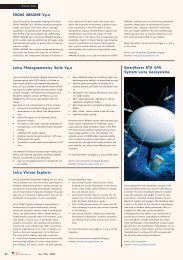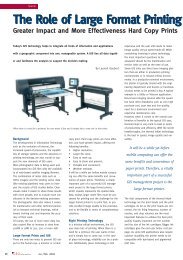2013 - Geoinformatics
2013 - Geoinformatics
2013 - Geoinformatics
Create successful ePaper yourself
Turn your PDF publications into a flip-book with our unique Google optimized e-Paper software.
41<br />
tion locations and profile paths: necessary<br />
if you want to copy projection files installed<br />
on your computer.<br />
Topics discussed in the book include: how<br />
to resolve alignment issues reflected in common<br />
error messages and warnings, how<br />
(and when) to perform geographic transformations<br />
and which transformation to use,<br />
how to decide which map projection to use,<br />
what do the parameters in a projection file<br />
mean and what do they do, how to add x,y<br />
data to a map and much more.<br />
Verdict<br />
As the author writes in the introduction of<br />
the book, understanding coordinate systems<br />
is a challenge. A practical guide like this is,<br />
therefore, indispensable. The decision to<br />
write a practical working manual which isn’t<br />
overly lengthy was a very wise one, since<br />
there are already many theoretical sources<br />
available, which tackle the mathematical<br />
theories behind map projections. Although<br />
this is not a theoretical book, of course there<br />
is theoretical information available, but it’s<br />
not the chief focus of the book.<br />
One could criticize the decision to repeat<br />
certain information provided in some chapters,<br />
but I didn’t find this distracting, since it<br />
allows you to read the parts of the book you<br />
need most in order to complete your work<br />
or solve a specific problem. This is not a<br />
book you probably will read from cover to<br />
cover, but will use as a reference guide or<br />
as a gateway, leading you to other sources.<br />
Anything more detailed would be information<br />
overload.<br />
What makes this publication so valuable, is<br />
the amount of experience reflected on every<br />
page of the book – the author undoubtedly<br />
has years of experience in solving problems<br />
about coordinate systems in ArcGIS. This<br />
book is clearly written by an expert and written<br />
and presented in an accessible way. As<br />
with all Esri books, there are many large<br />
illustrations, which clarify text examples.<br />
What is worth mentioning, however, is the<br />
amount of information on aligning CAD<br />
data, which is not an easy task, according<br />
to the author.<br />
The downside of this book is that the examples<br />
of coordinate systems and illustrations<br />
of sample data are taken from the United<br />
States. Given the scope of this book, this<br />
choice is understandable, but a missed<br />
opportunity in some way. Apart from this<br />
criticism, I found this a very informative and<br />
practical book to read, with tons of information,<br />
which should prove useful to every person<br />
working with coordinate systems in<br />
ArcGIS.<br />
For more information, have a look at: http://esripress.esri.com<br />
<br />
<br />
<br />
<br />
<br />
<br />
<br />
<br />
<br />
<br />
<br />
<br />
<br />
<br />
<br />
<br />
<br />
<br />
<br />
<br />
<br />
<br />
<br />
<br />
<br />
<br />
<br />
<br />
<br />
<br />
<br />
<br />
<br />
<br />
<br />
<br />
<br />
<br />
<br />
<br />
<br />
<br />
<br />
<br />
<br />
<br />
<br />
<br />
<br />
<br />
<br />
<br />
<br />
<br />
<br />
<br />
<br />
<br />
<br />
<br />
<br />
<br />
<br />
<br />
<br />
<br />
<br />
<br />
<br />
<br />
<br />
<br />
<br />
<br />
<br />
<br />
<br />
<br />
<br />
<br />
<br />
<br />
<br />
<br />
June <strong>2013</strong>










